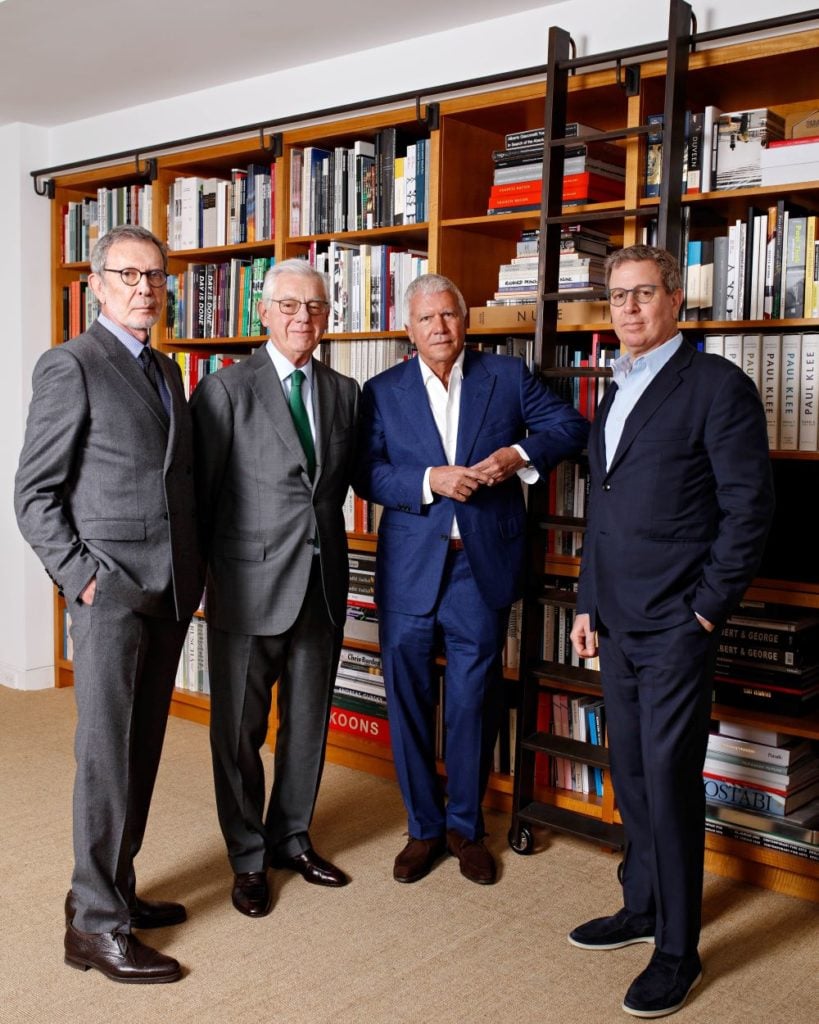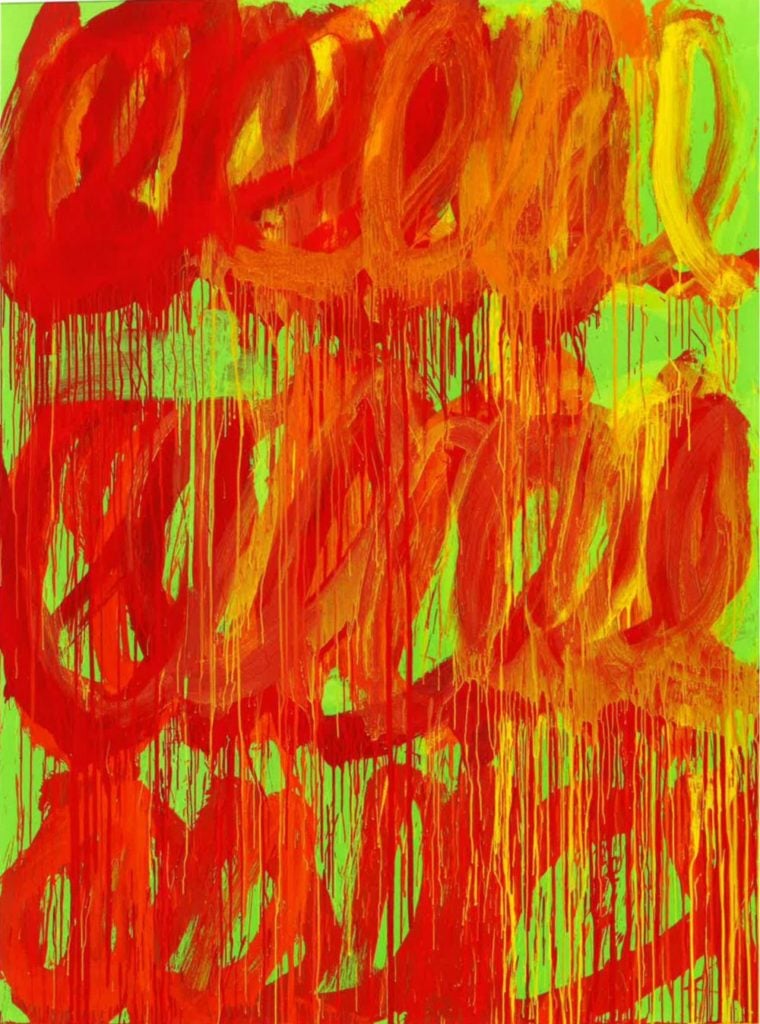Opinion
The Gray Market: Why an Ongoing Alliance of Mega-Dealers Suggests the Gallery System Is Still in Its Infancy (and Other Insights)
Our columnist explains why a joint venture between Acquavella, Gagosian, and Pace means gallery consolidation is only just getting started.

Every Monday morning, Artnet News brings you The Gray Market. The column decodes important stories from the previous week—and offers unparalleled insight into the inner workings of the art industry in the process
This week, going back to the future—or maybe ahead to the past…
FALL INTO THE AGP
On Wednesday, Michael Shnayerson served up a scoop in the midst of an in-depth Wall Street Journal profile of Pace Gallery founder Arne Glimcher. Just over six months after shaking up the art world with the announcement that his gallery would team up with fellow apex dealers Larry Gagosian and Bill Acquavella to place the collection of the late Donald Marron, Glimcher revealed that the Three Musketeers of high-end private sales would ride together again. Here’s Shnayerson:
So lucrative was the Marron sale that it’s bred a new business. “Our company is called AGP, for Acquavella, Gagosian and Pace,” Arne Glimcher says. “And it’s independent from our galleries.” The galleries will still face off but will come together for certain collections.
For clarity, what Shnayerson means by “certain collections” is “certain estates,” i.e., those of a scale and value that conventional thinking would conclude only Christie’s or Sotheby’s could handle. Expanding on what Bill Acquavella says in the piece, AGP’s existence improves the prospects of heirs and estate executors by providing more options, more competition, and maybe a better deal than they might get from the gavel gang alone.
The same day the WSJ published Shnayerson’s profile, the Canvas swooped in with some follow-up reporting on the nature of the AGP arrangement. The most important points clarified by the publication, via a Pace spokesperson, were that the collaboration exists as a separate entity that was founded in February 2020 for the sake of servicing the Marron collection; that there are “currently no plans” to staff it in a dedicated way; and that the question of whether other estates had already been approached by the troika was answered with the ever-enticing “no comment.”
I checked in with Pace myself on Friday to try to make sure I fully understood some of the other details mentioned by the Canvas. A gallery spokesperson confirmed that the collaborative entity is officially called AGP Ventures (“AGP” is internal shorthand) and that “future pitches to estates will be presented under AGP on behalf of the galleries.” (The Canvas also relayed that Pace president and CEO Marc Glimcher would likely represent Pace in these scenarios, but that a heavy hitter from Acquavella or Gagosian could be the entity’s main liaison to upcoming clients, as Glimcher was to the Marrons, depending on whose relationships are strongest.) The Pace spokesperson again demurred on the question of new estates, confirming only that AGP is still handling “ongoing business between the galleries related to the Marron collection.”
Although I don’t question for a moment that AGP Ventures will once again make its presence felt in the art market of the (near) future, there is a sense in which its continued existence pushes back against one of the key narratives of the trade’s recent developments. In fact, history even tempts me to wonder if, instead of signifying how professionalized the gallery sector has become, AGP actually underscores how embryonic the industry remains in the broader context of global business.

Cy Twombly, Camino Real (2011) © Cy Twombly Foundation. Courtesy the Donald B. Marron Family Collection, Acquavella Galleries, Gagosian, and Pace Gallery.
ROLL WITH THE WINNERS
I’ve written as much as anyone about how we’ve entered a “winner takes all” era in the art economy (and much of the larger economy) during the past generation. But the AGP collaboration proves that the reality is somewhat more complex than that vivid phrase implies.
Is it meaningful that three high-end dealers saw fit to join forces and successfully woo away the Marron estate, and potentially others to come, from the two biggest auction houses in the industry? Absolutely. But as I wrote when the alliance emerged as a one-off in late February, there were at least two significant private-dealing precedents in the 25 years prior. Neither resulted in a formal partnership, let alone an ongoing company. Still, they show that the Marron sale on its own wasn’t as novel as some observers made it out to be.
It’s arguable that AGP Ventures’s status as a going concern only reinforces that gallery-system consolidation is still far from its endgame. While it’s noteworthy that Acquavella, Gagosian, and Pace were able to outmaneuver and outspend the auction-house duopoly well into the nine-figure range—the Wall Street Journal reported that Christie’s and Sotheby’s offered the Marrons guarantees of “at least $300 million,” whereas Glimcher confirmed to Shnayerson that AGP advanced the family a total of $350 million—it’s just as noteworthy that the galleries pooled their resources to do it.
Close collaboration does not tend to be necessary when it comes to lucrative business opportunities in industries further along the “winner-takes-all” path. Consider the race to corner the market on self-driving cars, a goal now being pursued by titans in both Big Tech and Big Auto. You don’t see General Motors, Ford, and Toyota teaming up to compete against Amazon, Apple, and Google. Instead, each of these behemoths is pumping billions of dollars into developing its own autonomous-driving projects. They don’t need to join forces, and they don’t want to.
I can’t definitively say that Acquavella, Gagosian, and Pace had to form an alliance to win the Marron estate. But given that the highest plausible estimates I’ve ever heard for annual gross sales at Pace and Gagosian are $1 billion each, handing $350 million to a client up front strikes me as a dubious prospect for any single member of AGP. (Gagosian has been linked to the $1 billion figure by reputable outlets since at least 2016, and Shnayerson mentions that Marc Glimcher himself touted that Pace turned over that amount “or more” in recent years.) Even if one of these galleries could leverage up enough to pay such a fat guarantee, it’s no small feat to increase gross sales by something like 35 percent year over year.
To be clear, this is not a slam of AGP or the individual dealers comprising it. The day I start holding up Big Tech as a role model is the day that someone who cares about my wellbeing should rush to my apartment to make sure I’m not mumbling non-sequiturs to myself in the fetal position on my kitchen floor. However, I think this is a relatively clear-eyed view of the mile markers on the art industry’s journey. If we’re looking for cross-industry comps, the present contours of the art-sales business most closely match those of finance… if you rewind about 120 years.

The East Room of the Morgan Library and Museum, New York. Photography by Mike Peel. Courtesy of Wikimedia Commons.
TRUST, BUT VERIFY
As fate would have it, I’ve been reading Ron Chernow’s The House of Morgan, a nonfiction epic tracing the evolution of Wall Street through the history of the Morgan banking dynasty. As of this weekend, I’ve made it up to the 1920s (only about 600 pages to go!), and I’ve been struck over and over again by how much the adolescence of American finance resembles the current gallery system.
Take the fierce cloistering of company data. As per the gallery sector’s general modus operandi, in February, AGP declined to provide prices for the Marron works being sold or a valuation for the full collection. (Marc Glimcher told the Wall Street Journal that prices would be available only for works still unsold by the time they went on view in an exhibition of the collection later in the year.) You can guess where my mind went when I read that an 1870s stock prospectus for the New York Central Railroad stated that “the credit and status of the company are so well known, that it is scarcely necessary to make any public statement” about them—and thus, no one in the company did.
Another early Wall Street parallel is the industry-wide adherence to what Chernow calls the “Gentleman Banker’s Code”: a system by which a potential business partner’s perceived trustworthiness was often deemed the only collateral necessary to cement lucrative deals. A case in point was the 1901 formation of US Steel, a trust founded on a transaction worth north of $12.5 billion after adjusting for inflation… which took place after one of Andrew Carnegie’s surrogates gave a rousing speech at a dinner and, later, delivered a slip of paper with the proposed investment amount to J. Pierpont Morgan, who merely said, “I accept this price.” (A formal contract eventually followed, but only after the principles had already been proceeding for “weeks” as if the enterprise was a done deal.)
I bring up US Steel for a larger reason. To me, the most relevant parallel to AGP comes courtesy of the alliances forged between gargantuan industrialists and Wall Street deities to enable ascendant American interests to battle the established global powers of Europe at the outset of the 20th century. US Steel was one of these. The joint venture married what would otherwise have been the competing steel operations of Carnegie and Morgan into a monster “which would handle all phases of the business, from mining ore to marketing steel products.” Crucially, the resulting economies of scale and pooled resources would finally allow the most successful Americans to “compete in burgeoning world markets” instead of remaining strictly domestic.
If we think of the then-historically dominant European business interests as auction houses, it doesn’t take much imagination to see shadows of AGP and the estate business in the rest of the trust phase. Both are classic “the enemy of my enemy is my friend” scenarios featuring entrepreneurs who recognize the limits of their own capacities, as well as the larger opportunities they could seize by uniting on an ongoing venture—even as they continue to joust in others. Both also developed in the absence of industry-specific regulatory oversight and were able to materialize quickly due to an abnormally high degree of personal familiarity among the principals. (Only a few weeks elapsed between the Marron family soliciting bids from the major auction houses in January and the formation of AGP in February, with the genesis being Marc Glimcher, in his telling, simply calling up Larry Gagosian and Bill Acquavella to say they should “present an alternative to the family.”)
This is by no means a perfect comparison. But the fact remains that high finance in 2020 would barely be recognizable to the free-wheeling leaders of what Chernow calls its Baronial Age. At some point in the future, the same will be true of the gallery sector. I just suspect that point is much further away than last week’s art news might tempt us to think.
That’s all for this week. ‘Til next time, remember: everything looks colossal if you’re too close to it.
Follow artnet News on Facebook:
Want to stay ahead of the art world? Subscribe to our newsletter to get the breaking news, eye-opening interviews, and incisive critical takes that drive the conversation forward.

It looks like you're using an ad blocker, which may make our news articles disappear from your browser.
artnet News relies on advertising revenue, so please disable your ad blocker or whitelist our site.
To do so, simply click the Ad Block icon, usually located on the upper-right corner of your browser. Follow the prompts from there.
SHARE
